Deck 8: Late Antiquity
Question
Question
Question
Question
Question
Question
Question
Question
Question
Question
Question
Question
Question
Question
Question
Question
Question
Question
Question
Question
Question
Question
Question
Question
Question
Question
Question
Question
Question
Question
Question
Question
Question
Question
Question
Question
Question
Question
Question
Question
Question
Question
Question
Question
Question
Question
Question
Question
Question
Question

Unlock Deck
Sign up to unlock the cards in this deck!
Unlock Deck
Unlock Deck
1/50
Play
Full screen (f)
Deck 8: Late Antiquity
1
What is the correct term for the entrance porch of Old Saint Peter's in Rome?
A) Atrium
B) Narthex
C) Nave
D) Bema
A) Atrium
B) Narthex
C) Nave
D) Bema
B
2

What is the subject of the scene that occupies the left third of the sarcophagus of Santa Maria Antiqua shown here?
A) Serpent in Eden
B) Temptation of Christ
C) Noah's ark
D) Salvation of Jonah

What is the subject of the scene that occupies the left third of the sarcophagus of Santa Maria Antiqua shown here?
A) Serpent in Eden
B) Temptation of Christ
C) Noah's ark
D) Salvation of Jonah
D
3
What do the mural paintings at Dura-Europos suggest was a component of the decoration of many Late Antique synagogues?
A) Images of the cross
B) Narrative scenes
C) Praying figures
D) Abstract ornament
A) Images of the cross
B) Narrative scenes
C) Praying figures
D) Abstract ornament
B
4
Which of the following has a basilica form?
A) Santa Costanza
B) Old Saint Peter's
C) Saints Peter and Marcellinus
D) Saint Callixtus
A) Santa Costanza
B) Old Saint Peter's
C) Saints Peter and Marcellinus
D) Saint Callixtus

Unlock Deck
Unlock for access to all 50 flashcards in this deck.
Unlock Deck
k this deck
5
Why did the Roman state persecute the Christians?
A) Christians fomented revolt against the Roman state.
B) Christians refused to pay homage to the state's gods.
C) Romans knew the Christians would be their downfall.
D) Romans didn't approve of anything originating in Judea.
A) Christians fomented revolt against the Roman state.
B) Christians refused to pay homage to the state's gods.
C) Romans knew the Christians would be their downfall.
D) Romans didn't approve of anything originating in Judea.

Unlock Deck
Unlock for access to all 50 flashcards in this deck.
Unlock Deck
k this deck
6
What is the earliest datable Christian art?
A) First century CE
B) Fifth century CE
C) Sixth century CE
D) Mid-third century CE
A) First century CE
B) Fifth century CE
C) Sixth century CE
D) Mid-third century CE

Unlock Deck
Unlock for access to all 50 flashcards in this deck.
Unlock Deck
k this deck
7
Who was a popular subject in early Christian art because he was seen as a prefiguration of Christ?
A) Moses
B) King David
C) Jeremiah
D) Jonah
A) Moses
B) King David
C) Jeremiah
D) Jonah

Unlock Deck
Unlock for access to all 50 flashcards in this deck.
Unlock Deck
k this deck
8
Which of the following statements accurately explains why the diptych of the Nicomachi and the Symmachi is significant to the art tradition of fourth-century Rome?
A) It initiated the traditional religious subjects in ivory carving.
B) It deliberately continued the classical tradition.
C) It adapted classical tradition for a Christian wedding gift.
D) The diptych becomes a certificate of marriage.
A) It initiated the traditional religious subjects in ivory carving.
B) It deliberately continued the classical tradition.
C) It adapted classical tradition for a Christian wedding gift.
D) The diptych becomes a certificate of marriage.

Unlock Deck
Unlock for access to all 50 flashcards in this deck.
Unlock Deck
k this deck
9
Why is a family group shown praying in the lunette of the Catacomb of Saints Peter and Marcellinus?
A) They represent the ideal Christian family.
B) They represent the Christian family who own that section of the catacomb.
C) They represent nothing specific, just figures to fill the space.
D) They represent the Christian family seeking their heavenly reward.
A) They represent the ideal Christian family.
B) They represent the Christian family who own that section of the catacomb.
C) They represent nothing specific, just figures to fill the space.
D) They represent the Christian family seeking their heavenly reward.

Unlock Deck
Unlock for access to all 50 flashcards in this deck.
Unlock Deck
k this deck
10
What invention greatly aided the distribution of manuscripts during the Early Roman Empire?
A) Narrative column
B) Diptych
C) Codex
D) Chariot
A) Narrative column
B) Diptych
C) Codex
D) Chariot

Unlock Deck
Unlock for access to all 50 flashcards in this deck.
Unlock Deck
k this deck
11
The illustrated book had a long history in the ancient world. When did the tradition of placing pictures in manuscripts first begin?
A) Classical Greece
B) Pharaonic Egypt
C) Sumerian cuneiform
D) Republican Rome
A) Classical Greece
B) Pharaonic Egypt
C) Sumerian cuneiform
D) Republican Rome

Unlock Deck
Unlock for access to all 50 flashcards in this deck.
Unlock Deck
k this deck
12
Which phrase best describes the style of the Christ as Good Shepherd mosaic from the Mausoleum of Galla Placidia at Ravenna?
A) Features abstracted designs
B) Closely related to Jewish art
C) Entirely in the Byzantine style
D) Deeply rooted in the classical tradition
A) Features abstracted designs
B) Closely related to Jewish art
C) Entirely in the Byzantine style
D) Deeply rooted in the classical tradition

Unlock Deck
Unlock for access to all 50 flashcards in this deck.
Unlock Deck
k this deck
13
Why did Constantine locate the earliest public Christian churches on the outskirts of Rome?
A) To comply with Roman law
B) To promote Christianity
C) To avoid confrontations
D) To keep religious structures in the same part of city
A) To comply with Roman law
B) To promote Christianity
C) To avoid confrontations
D) To keep religious structures in the same part of city

Unlock Deck
Unlock for access to all 50 flashcards in this deck.
Unlock Deck
k this deck
14
Which of the following attributes was used to depict Christ after Christianity was officially recognized by Roman authorities?
A) Chariot
B) Imperial armor
C) Imperial purple
D) Laurel leaf crown
A) Chariot
B) Imperial armor
C) Imperial purple
D) Laurel leaf crown

Unlock Deck
Unlock for access to all 50 flashcards in this deck.
Unlock Deck
k this deck
15
Which of the following is the closest predecessor for Santa Costanza?
A) Tomb of the Julii
B) Mausoleum of Galla Placidia
C) Pantheon
D) Sant'Apollinare Nuovo
A) Tomb of the Julii
B) Mausoleum of Galla Placidia
C) Pantheon
D) Sant'Apollinare Nuovo

Unlock Deck
Unlock for access to all 50 flashcards in this deck.
Unlock Deck
k this deck
16
Which body of subject matter survives in the decoration of the Mildenhall Treasure, especially the "Great Dish"?
A) Republican portraiture
B) Landscape vistas
C) Jewish iconography
D) Greco-Roman iconography
A) Republican portraiture
B) Landscape vistas
C) Jewish iconography
D) Greco-Roman iconography

Unlock Deck
Unlock for access to all 50 flashcards in this deck.
Unlock Deck
k this deck
17
Scenes from which artistic group accompany the Christian images in the mural program at Santa Costanza?
A) Illustrated Vergil manuscripts
B) Roman funerary art
C) Roman narrative reliefs
D) Greek mythology
A) Illustrated Vergil manuscripts
B) Roman funerary art
C) Roman narrative reliefs
D) Greek mythology

Unlock Deck
Unlock for access to all 50 flashcards in this deck.
Unlock Deck
k this deck
18
Why is the Christian community house in Dura-Europos such a small building?
A) There was little land available for large buildings in Dura-Europos.
B) No large dwellings were constructed in Dura-Europos.
C) Christians did not yet enjoy the patronage of the Roman state.
D) No shrines or holy structures were allowed in Dura-Europos.
A) There was little land available for large buildings in Dura-Europos.
B) No large dwellings were constructed in Dura-Europos.
C) Christians did not yet enjoy the patronage of the Roman state.
D) No shrines or holy structures were allowed in Dura-Europos.

Unlock Deck
Unlock for access to all 50 flashcards in this deck.
Unlock Deck
k this deck
19
Which scene on the sarcophagus of Junius Bassus is an allusion to the crucifixion?
A) Entry into Jerusalem
B) Christ enthroned
C) Christ before Pilate
D) Christ between Saints Peter and Paul
A) Entry into Jerusalem
B) Christ enthroned
C) Christ before Pilate
D) Christ between Saints Peter and Paul

Unlock Deck
Unlock for access to all 50 flashcards in this deck.
Unlock Deck
k this deck
20
How did one recognize a Christian sarcophagus?
A) The name of the person buried was carved in its central panel.
B) The iconography in its reliefs is predominantly Christian.
C) The crucifixion always appeared among the relief scenes.
D) Sarcophagi were used for burial only by Christians.
A) The name of the person buried was carved in its central panel.
B) The iconography in its reliefs is predominantly Christian.
C) The crucifixion always appeared among the relief scenes.
D) Sarcophagi were used for burial only by Christians.

Unlock Deck
Unlock for access to all 50 flashcards in this deck.
Unlock Deck
k this deck
21
Where have archaeologists found the oldest-known Christian iconographical program?
A) Via Latina Catacomb, Rome
B) Community house, Dura-Europos
C) Old Saint Peter's, Rome
D) Mausoleum of Galla Placidia, Ravenna
A) Via Latina Catacomb, Rome
B) Community house, Dura-Europos
C) Old Saint Peter's, Rome
D) Mausoleum of Galla Placidia, Ravenna

Unlock Deck
Unlock for access to all 50 flashcards in this deck.
Unlock Deck
k this deck
22
What Latin term was used to describe a manuscript in scroll form?
A) Folio
B) Codex
C) Rotulus
D) Vellum
A) Folio
B) Codex
C) Rotulus
D) Vellum

Unlock Deck
Unlock for access to all 50 flashcards in this deck.
Unlock Deck
k this deck
23
How was natural light provided in Early Christian basilicas?
A) Baldacchino ovals
B) Hypostyle halls
C) Clerestory windows
D) Oculus in narthex
A) Baldacchino ovals
B) Hypostyle halls
C) Clerestory windows
D) Oculus in narthex

Unlock Deck
Unlock for access to all 50 flashcards in this deck.
Unlock Deck
k this deck
24
From where and to where did Honorius, Emperor of the West, move his capital?
A) Rome to Constantinople
B) Ravenna to Thesssaloniki
C) Rome to Ravenna
D) Milan to Ravenna
A) Rome to Constantinople
B) Ravenna to Thesssaloniki
C) Rome to Ravenna
D) Milan to Ravenna

Unlock Deck
Unlock for access to all 50 flashcards in this deck.
Unlock Deck
k this deck
25
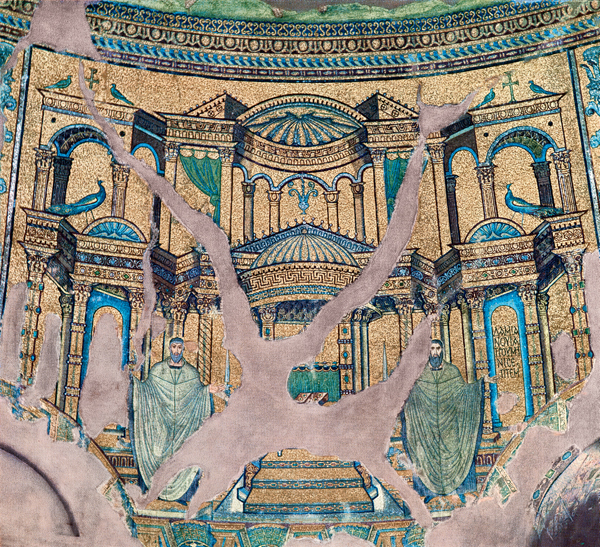
What activity is implied by the gestures of the two male figures in this mosaic?
A) Lecturing
B) Blessing
C) Baptism
D) Praying

What activity is implied by the gestures of the two male figures in this mosaic?
A) Lecturing
B) Blessing
C) Baptism
D) Praying

Unlock Deck
Unlock for access to all 50 flashcards in this deck.
Unlock Deck
k this deck
26
Which early church gives prominence to the life of the Virgin Mary in its decorative program?
A) San Vitale
B) Santa Maria Maggiore
C) Santa Sabina
D) Hagios Giorgios
A) San Vitale
B) Santa Maria Maggiore
C) Santa Sabina
D) Hagios Giorgios

Unlock Deck
Unlock for access to all 50 flashcards in this deck.
Unlock Deck
k this deck
27
In what role was Christ depicted in much Early Christian art?
A) Sol Invictus
B) Good Shepherd
C) Enthroned emperor
D) Pantokrator
A) Sol Invictus
B) Good Shepherd
C) Enthroned emperor
D) Pantokrator

Unlock Deck
Unlock for access to all 50 flashcards in this deck.
Unlock Deck
k this deck
28
Where was the Mildenhall Treasure found?
A) Egypt
B) England
C) Syria
D) Italy
A) Egypt
B) England
C) Syria
D) Italy

Unlock Deck
Unlock for access to all 50 flashcards in this deck.
Unlock Deck
k this deck
29
Which Roman monument do the figures in the painting illustrating the Book of Samuel in the synagogue at Dura-Europos LEAST resemble?
A) Arch of Constantine
B) Arch of Septimius Severus
C) Column of Antoninus Pius
D) Column of Trajan
A) Arch of Constantine
B) Arch of Septimius Severus
C) Column of Antoninus Pius
D) Column of Trajan

Unlock Deck
Unlock for access to all 50 flashcards in this deck.
Unlock Deck
k this deck
30
Who was the Ostrogothic patron of the church of Sant'Apollinare Nuovo in Ravenna?
A) Justinian
B) Alaric
C) Theodoric
D) Trajan Decius
A) Justinian
B) Alaric
C) Theodoric
D) Trajan Decius

Unlock Deck
Unlock for access to all 50 flashcards in this deck.
Unlock Deck
k this deck
31
Which term describes the cross-inscribed halo of a Christian saint?
A) Cruciform
B) Nimbus
C) Attribute
D) Sanctus
A) Cruciform
B) Nimbus
C) Attribute
D) Sanctus

Unlock Deck
Unlock for access to all 50 flashcards in this deck.
Unlock Deck
k this deck
32
What change was introduced in the mosaics of Sant'Apollinare Nuovo?
A) Use of tesserae
B) Architectural fantasies
C) Gold background
D) Natural landscape
A) Use of tesserae
B) Architectural fantasies
C) Gold background
D) Natural landscape

Unlock Deck
Unlock for access to all 50 flashcards in this deck.
Unlock Deck
k this deck
33
Which architectural form did Christian architects choose to adopt for the first public buildings where the Christian liturgy would be celebrated?
A) Temple
B) Council house
C) Domus
D) Basilica
A) Temple
B) Council house
C) Domus
D) Basilica

Unlock Deck
Unlock for access to all 50 flashcards in this deck.
Unlock Deck
k this deck
34
The word tessera, used to describe small mosaic tiles, comes from the Latin word for which of the following?
A) Four
B) Treasure
C) Cube
D) Split
A) Four
B) Treasure
C) Cube
D) Split

Unlock Deck
Unlock for access to all 50 flashcards in this deck.
Unlock Deck
k this deck
35
The exterior of Santa Sabina in Rome most closely resembled the exterior of which building?
A) Santa Costanza, Rome
B) Mausoleum of Galla Placidia, Ravenna
C) Hagios Giorgios, Thessaloniki
D) Aula Palatina, Trier
A) Santa Costanza, Rome
B) Mausoleum of Galla Placidia, Ravenna
C) Hagios Giorgios, Thessaloniki
D) Aula Palatina, Trier

Unlock Deck
Unlock for access to all 50 flashcards in this deck.
Unlock Deck
k this deck
36
Why are there very few depictions of the crucifixion in early Christian art?
A) The episode was not known until the circulation of the Gospels in the fourth century.
B) Artists emphasized the divinity of Christ through his life as a teacher and miracle worker.
C) Christians were afraid to make accusations of murder against the Roman government.
D) Christians did not want to emphasize his suffering and martyrdom.
A) The episode was not known until the circulation of the Gospels in the fourth century.
B) Artists emphasized the divinity of Christ through his life as a teacher and miracle worker.
C) Christians were afraid to make accusations of murder against the Roman government.
D) Christians did not want to emphasize his suffering and martyrdom.

Unlock Deck
Unlock for access to all 50 flashcards in this deck.
Unlock Deck
k this deck
37
What is the Mausoleum of Galla Placidia most notable for?
A) Exterior marble revetment
B) Interior frescoes
C) Exterior sculptural program
D) Interior mosaic program
A) Exterior marble revetment
B) Interior frescoes
C) Exterior sculptural program
D) Interior mosaic program

Unlock Deck
Unlock for access to all 50 flashcards in this deck.
Unlock Deck
k this deck
38
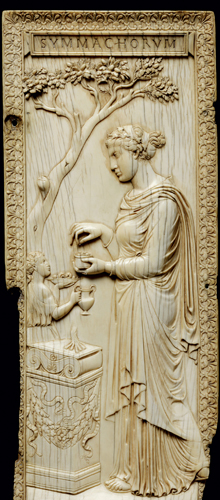
Which motif appearing on this ivory plaque ties the piece to the Christian tradition?
A) Altar
B) Ivy crown
C) None
D) Drapery

Which motif appearing on this ivory plaque ties the piece to the Christian tradition?
A) Altar
B) Ivy crown
C) None
D) Drapery

Unlock Deck
Unlock for access to all 50 flashcards in this deck.
Unlock Deck
k this deck
39
In 380 CE, who declared Christianity the official religion of the Roman Empire?
A) Alaric
B) Theodore
C) Theodosius I
D) Honorius
A) Alaric
B) Theodore
C) Theodosius I
D) Honorius

Unlock Deck
Unlock for access to all 50 flashcards in this deck.
Unlock Deck
k this deck
40
The plan of the church of Santa Costanza is a forerunner of which regional variant?
A) Western basilica
B) Western catacomb
C) Northern monastery
D) Eastern central-plan building
A) Western basilica
B) Western catacomb
C) Northern monastery
D) Eastern central-plan building

Unlock Deck
Unlock for access to all 50 flashcards in this deck.
Unlock Deck
k this deck
41
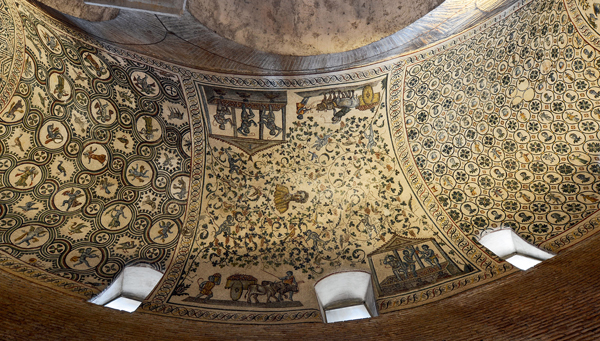
What is the Christian interpretation of these vineyard scenes?
A) Bacchus
B) Fertility and plenty
C) Garden of Eden
D) The Eucharist and blood of Christ

What is the Christian interpretation of these vineyard scenes?
A) Bacchus
B) Fertility and plenty
C) Garden of Eden
D) The Eucharist and blood of Christ

Unlock Deck
Unlock for access to all 50 flashcards in this deck.
Unlock Deck
k this deck
42
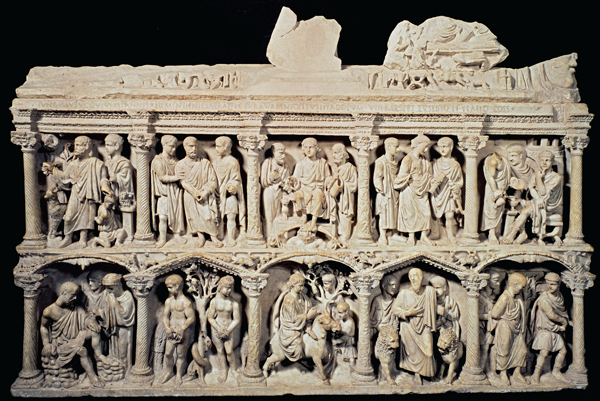
How is the figure of Jesus depicted here on the sarcophagus of Junius Bassus?
A) As the Good Shepherd
B) As a wise teacher
C) Like a Roman emperor
D) Like the Pantokrator

How is the figure of Jesus depicted here on the sarcophagus of Junius Bassus?
A) As the Good Shepherd
B) As a wise teacher
C) Like a Roman emperor
D) Like the Pantokrator

Unlock Deck
Unlock for access to all 50 flashcards in this deck.
Unlock Deck
k this deck
43
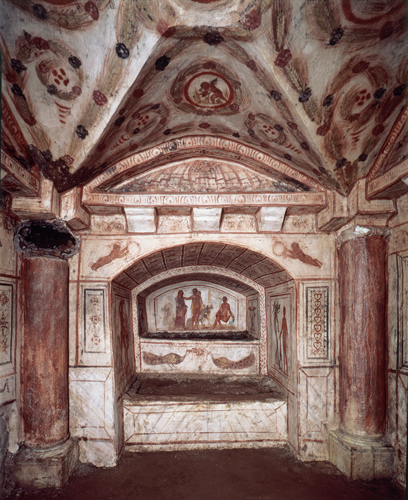
What Greco-Roman figure is celebrated in the painting program of Cubiculum N, seen here?
A) Theseus
B) Hercules
C) Augustus
D) Jupiter

What Greco-Roman figure is celebrated in the painting program of Cubiculum N, seen here?
A) Theseus
B) Hercules
C) Augustus
D) Jupiter

Unlock Deck
Unlock for access to all 50 flashcards in this deck.
Unlock Deck
k this deck
44
What architectural term names the vestibule area of a Christian church?
A) Apse
B) Atrium
C) Transept
D) Narthex
A) Apse
B) Atrium
C) Transept
D) Narthex

Unlock Deck
Unlock for access to all 50 flashcards in this deck.
Unlock Deck
k this deck
45
What architectural element was introduced in the church of Santa Costanza?
A) Mausoleum
B) Ambulatory
C) Narthex
D) Dome
A) Mausoleum
B) Ambulatory
C) Narthex
D) Dome

Unlock Deck
Unlock for access to all 50 flashcards in this deck.
Unlock Deck
k this deck
46
What biblical figure was the focus of the mosaics of Santa Maria Maggiore?
A) Jesus
B) Jonas
C) Virgin Mary
D) King David
A) Jesus
B) Jonas
C) Virgin Mary
D) King David

Unlock Deck
Unlock for access to all 50 flashcards in this deck.
Unlock Deck
k this deck
47
Which of the following is NOT characteristic of Late Antique Christian art?
A) Non-naturalistic
B) Shade and tonality
C) Hieratic sizing
D) Frontal figures
A) Non-naturalistic
B) Shade and tonality
C) Hieratic sizing
D) Frontal figures

Unlock Deck
Unlock for access to all 50 flashcards in this deck.
Unlock Deck
k this deck
48
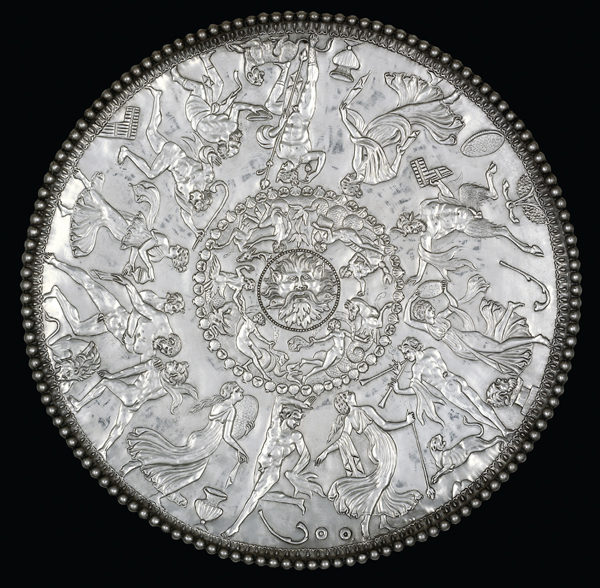
What is the subject of the two inner rings of the "Great Dish" from the Mildenhall Treasure, shown here?
A) Dionysus and maenads
B) Jupiter and dolphins
C) Oceanus and Nereids
D) Neptune and putti

What is the subject of the two inner rings of the "Great Dish" from the Mildenhall Treasure, shown here?
A) Dionysus and maenads
B) Jupiter and dolphins
C) Oceanus and Nereids
D) Neptune and putti

Unlock Deck
Unlock for access to all 50 flashcards in this deck.
Unlock Deck
k this deck
49
Which aspect of Greco-Roman temple architecture was retained in the Early Christian basilica?
A) Open-air altar
B) Marble tile roof
C) Pseudoperipteral colonnade
D) East-west orientation
A) Open-air altar
B) Marble tile roof
C) Pseudoperipteral colonnade
D) East-west orientation

Unlock Deck
Unlock for access to all 50 flashcards in this deck.
Unlock Deck
k this deck
50
What is the term that describes the identifying objects or garments accompanying saints and other figures as a means of identifying them to the viewer?
A) Type
B) Figuration
C) Attribute
D) Relic
A) Type
B) Figuration
C) Attribute
D) Relic

Unlock Deck
Unlock for access to all 50 flashcards in this deck.
Unlock Deck
k this deck



